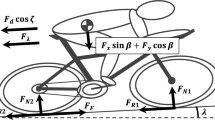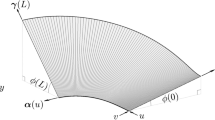Abstract
This work outlines the creation of a model of a velodrome datum line constructed from two straights, two circular-arc bends, and four transition curves. Different transition curve options are outlined and contrasted with a model with no transition curves. The influence of velodrome geometry on the wheel speed, wheel acceleration, roll angle, roll rate, and power demand of a theoretical cyclist is presented. The results display similar wheel speeds and roll angles for different transition curves, with larger differences when compared to the no-transition-curve option. Greater differences are observed in the acceleration and roll rate, for which calculations are only possible when using a transition curve. Comparisons of the model with theodolite measurements of two velodromes show a mean minimum root mean square error of 0.0398 m. This work can be used to increase the accuracy of existing track-cycling analytic models.








Similar content being viewed by others
Abbreviations
- ′:
-
(Prime) derivative with respect to lap distance
- \(\mathop {}\limits^{ \cdot }\) :
-
(Over-dot) derivative with respect to time
- \(Y\) :
-
Track half width (m)
- \(R\) :
-
Track mid-bend radius (m)
- \(\kappa\) :
-
Curvature (/m)
- \(\psi\) :
-
Curve tangential angle (rad)
- \(a\) :
-
Scaling factor
- \(\tau\) :
-
Curve parameter (m)
- \({K}\) :
-
Transition curve curvature profile (/m)
- \(({x}_{\text{T}},{y}_{\text{T}})\) :
-
Coordinates of the transition curve (m, m)
- \(({x}_{\text{B}},{y}_{\text{B}})\) :
-
Coordinates of the bend (m, m)
- \(({x}_{S},{y}_{S})\) :
-
Coordinates of the straight (m, m)
- \(({x}_{\text{Tc}},{y}_{\text{Tc}})\) :
-
Coordinates of the transition curve centre of curvature (m, m)
- \(({x}_{\text{Bc}},{y}_{\text{Bc}})\) :
-
Coordinates of the bend centre of curvature (m, m)
- \({L}_{L}\) :
-
Length of the lap (m)
- \({L}_{\text{T}}\) :
-
Length of the transition curve (m)
- \({L}_{\text{B}}\) :
-
Length of the bend (m)
- \({L}_{\text{S}}\) :
-
Length of the straight (m)
- \(\beta\) :
-
Track bank angle (rad)
- \({V}_{\text{W}}\) :
-
Velocity of the wheels (m/s)
- \({V}_{\text{CG}}\) :
-
Velocity of the centre of gravity (m/s)
- \({V}_{\text{A}}\) :
-
Velocity of the air relative to the cyclist (m/s)
- \({a}_{\text{W}}\) :
-
Acceleration of the wheels (m/s2)
- \({a}_{\text{CG}}\) :
-
Acceleration of the centre of gravity (m/s2)
- \(\phi\) :
-
Roll angle (rad)
- \({C}_{\text{D}}A\) :
-
Aerodynamic drag area (m2)
- \({C}_{\text{RR}}\) :
-
Coefficient of rolling resistance
- \({\mu }_{\text{s}}\) :
-
Coefficient of scrubbing resistance (/rad)
- \(\eta\) :
-
Drivetrain efficiency
- \(\rho\) :
-
Air density (kg/m3)
- \({h}_{\text{CG}}\) :
-
Height of the centre of gravity (m)
- \(m\) :
-
Combined cyclist/bicycle mass (kg)
- \(g\) :
-
Gravitational acceleration (m/s2)
References
Caddy O, Fitton W, Symons D, Purnell A, Gordon D (2017) The effects of forward rotation of posture on computer-simulated 4-km track cycling: Implications of Union Cycliste Internationale rule 1.3.013. Proc Inst Mech Eng Part P J Sports Eng Technol 231(1):3–13. https://doi.org/10.1177/1754337115619306
Underwood L, Jermy M (2014) Determining optimal pacing strategy for the track cycling individual pursuit event with a fixed energy mathematical model. Sports Eng 17(4):183–196. https://doi.org/10.1007/s12283-014-0153-3
Fitton B, Symons D (2018) A mathematical model for simulating cycling: applied to track cycling. Sports Eng 21(4):409–418. https://doi.org/10.1007/s12283-018-0283-0
Fitzgerald S, Kelso R, Grimshaw P, Warr A (2019) Measurement of the air velocity and turbulence in a simulated track cycling team pursuit race. J Wind Eng Ind Aerodyn 190:322–330. https://doi.org/10.1016/j.jweia.2019.05.014
Union Cycliste Internationale (2020) UCI cycling regulations: part III: track races. Version 12.06.2020. https://www.uci.org/inside-uci/constitutions-regulations/regulations
Martin J, Gardner AS, Barras M, Martin D (2006) Modeling sprint cycling using field-derived parameters and forward integration. Med Sci Sports Exerc 38(3):592–597. https://doi.org/10.1249/01.mss.0000193560.34022.04
Underwood L, Jermy M (2010) Mathematical model of track cycling: the individual pursuit. Procedia Eng 2(2):3217–3222. https://doi.org/10.1016/j.proeng.2010.04.135
Lukes R, Carre M, Haake S (2006) Track cycling: an analytical model. Eng Sport 6:115–120. https://doi.org/10.1007/978-0-387-46050-5_21
Benham G, Cohen C, Brunet E, Clanet C (2020) Brachistochrone on a velodrome. Proc R Soc A Math Phys Eng Sci 476(2238):20200153. https://doi.org/10.1098/rspa.2020.0153
Lukes R, Hart J, Haake S (2012) An analytical model for track cycling. Proc Inst Mech Eng Part P J Sports Eng Technol 226(2):143–151. https://doi.org/10.1177/1754337111433242
Bos L, Slawinski MA, Slawinski RA, Stanoev T (2021) On modelling bicycle power for velodromes: Part II. Formulation for individual pursuits. [Preprint] Version 08.01.2021. https://arxiv.org/abs/2009.01162
Bartels RH, Beatty JC, Barsky BA (1987) An introduction to splines for use in computer graphics and geometric modeling. Morgan Kaufmann, San Francisco
Brustad TF, Dalmo R (2020) Railway transition curves: a review of the state-of-the-art and future research. Infrastructures 5(5):43. https://doi.org/10.3390/infrastructures5050043
Pendrill A-M, Eager D (2020) Velocity, acceleration, jerk, snap and vibration: forces in our bodies during a roller coaster ride. Phys Educ 55(6):065012. https://doi.org/10.1088/1361-6552/aba732
Meek DS, Walton DJ (1989) The use of Cornu spirals in drawing planar curves of controlled curvature. J Comput Appl Math 25(1):69–78. https://doi.org/10.1016/0377-0427(89)90076-9
Nutbourne AW, McLellan PM, Kensit RML (1972) Curvature profiles for plane curves. Comput Aided Des 4(4):176–184. https://doi.org/10.1016/0010-4485(72)90072-3
Gladstone H (2011) Making tracks: building the Olympic velodrome. https://www.cyclingweekly.com/news/making-tracks-building-the-olympic-velodrome-53916. Accessed 12 Nov 2020
Martin J, Milliken D, Cobb J, McFadden K, Coggan A (1998) Validation of a mathematical model for road cycling power. J Appl Biomech 14(3):276–291. https://doi.org/10.1123/jab.14.3.276
Elhassan IM, Ali AS (2011) Comparative study of accuracy in distance measurement using: optical and digital levels. J King Saud Univ Eng Sci 23(1):15–19. https://doi.org/10.1016/j.jksues.2010.10.001
Gander W, Golub GH, Strebel R (1994) Least-squares fitting of circles and ellipses. BIT Numer Math 34(4):558–578. https://doi.org/10.1007/BF01934268
Hossain MI, Eager D, Walker PD (2020) Greyhound racing ideal trajectory path generation for straight to bend based on jerk rate minimization. Sci Rep 10(1):7088. https://doi.org/10.1038/s41598-020-63678-1
Mahdavi F, Hossain MI, Hayati H, Eager D, Kennedy P (2018) Track shape, resulting dynamics and injury rates of greyhounds. In: ASME 2018 international mechanical engineering congress and exposition. Volume 13: design, reliability, safety, and risk. https://doi.org/10.1115/imece2018-87156
World Athletics (2019) Track and field facilities manual 2019 edition—chapters 1–3. Version 01.11.2019. https://www.worldathletics.org/about-iaaf/documents/technical-information
Author information
Authors and Affiliations
Corresponding author
Ethics declarations
Conflict of interest
The authors have no conflicts of interest to declare.
Additional information
Publisher's Note
Springer Nature remains neutral with regard to jurisdictional claims in published maps and institutional affiliations.
Supplementary Information
Below is the link to the electronic supplementary material.
Rights and permissions
About this article
Cite this article
Fitzgerald, S., Kelso, R., Grimshaw, P. et al. Impact of transition design on the accuracy of velodrome models. Sports Eng 24, 23 (2021). https://doi.org/10.1007/s12283-021-00360-3
Accepted:
Published:
DOI: https://doi.org/10.1007/s12283-021-00360-3




